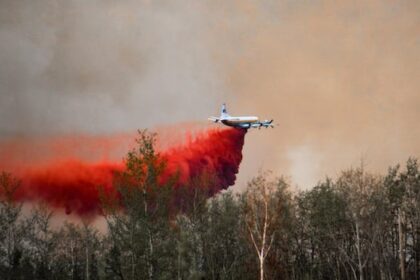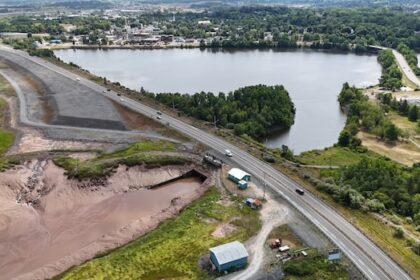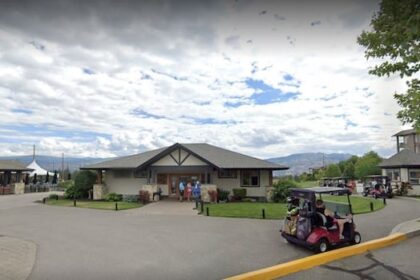On the morning of Monday, Sept. 15, James Smith begrudgingly got out of bed to get ready for the day. The weekend, he told The Narwhal, had been hell. “Even this morning, it was like 75 to 80 decibels inside my bedroom,” he said on a phone call from his home in Kitimat, B.C., referring to the noise. That’s like his bed was in the middle of a busy city street. The sound was from LNG Canada, the first major liquefied natural gas (LNG) export operation in the country. Ever since it fired up its gas turbines, compressors and flare earlier this year, some residents of the small northwestern community have had their lives upended. “We maybe got two hours’ sleep this whole weekend,” Smith, whose name has been changed, said. “I’m just useless now.” The Narwhal knows his name but agreed to refer to him by a pseudonym to protect his identity and prevent potential repercussions to his family. Smith explained he felt it was necessary to protect his family in a town of around 8,000 people, where most are connected to or working for the LNG industry in some way and criticizing it publicly isn’t common. LNG Canada was built in the Kitimat River estuary, just down the hill from the town centre and a stone’s throw from residential neighbourhoods. As the massive export plant gets its operations up and running, some Kitimat residents say their lives have been upended. Photo: Marty Clemens / The Narwhal A few days earlier, LNG Canada posted a notification to its website and social media channels, warning locals of a “planned flaring activity” as the facility restarted two of its four turbines. Flaring is burning off excess or waste natural gas, mostly composed of methane. The flame can sometimes get as high as 100 metres. “We anticipate increased noise and visible emissions from the flare,” the notification said. LNG Canada posted notifications related to flaring 23 times since September last year, some of which have included “unplanned flaring” events. A spokesperson with the consortium of companies behind the project told The Narwhal “a new facility the size and complexity of LNG Canada requires a break-in period to stabilize, which is normal.” The companies behind LNG Canada are all from, and in three cases owned by, other countries: Royal Dutch Shell, by way of Shell Canada, Malaysia’s state-owned Petronas, the Chinese government’s PetroChina, South Korea’s KoGas, and the Japanese corporation, Mitsubishi. Together with North American pipeline giant, TC Energy, which built the Coastal GasLink pipeline that feeds the plant, the companies represent what has been called the largest private investment in Canadian history. As the liquefaction plant gets going, “occasional adjustments, fine-tuning and restarts may initiate flaring activities outside of scheduled or planned events,” the spokesperson added. “These are typically brief and like all flaring activities, they are reported to the BC Energy Regulator and communicated to the public.” Kitimat has been an industry town since it was settled in the 1950s to support the Alcan aluminum smelter, now owned by multinational mining giant Rio Tinto. Before moving west, Smith, who is a mechanical engineer and millwright, worked on some of the biggest energy projects in Canada. Kitimat offered him an alluring combination: the chance to make a decent salary running his own contracting team and easy access to good hiking, fishing and hunting. “I moved here for the peace and quiet in the mountains,” he said. When construction of LNG Canada started in 2020, most of his workforce evaporated as his employees went to work on building the plant. So he signed on, too. His skill set and expertise made him a perfect candidate, but after witnessing what he described as a “nightmare” of safety issues and endless problems with components sourced overseas, Smith quit working on the giant gas processing facility and went back to contracting. LNG Canada did not directly respond to allegations of safety issues but said it is “committed to operating safely, transparently and in compliance with all provincial and federal regulations.” Construction of LNG Canada started in 2020 and the plant sent its first shipment overseas in June 2025. Smith said most of his employees quit to work on building the facility. Photo: Marty Clemens / The Narwhal With the LNG plant now running, Smith’s dreams of a quiet life are crumbling. “I’m at a wit’s end with the noise and the smoke,” he said. “I built this house with my own hands. I dug the foundation, poured the concrete. I put everything I own, all my savings, into it. Now I can’t even sleep in my house, it’s so noisy.” ‘Worsening symptoms’: Kitimat registered nurse concerned increased reports of respiratory problems linked to flaring It’s not just the industrial noise concerning Smith and other Kitimat residents. As The Narwhal previously reported, flaring has meant a significant increase in emissions, affecting some neighbourhoods more acutely than others. “At 2:45, my backyard was covered in grey smoke when I was cooking hot dogs,” Smith said. “You get this smell for a few seconds. It smells like burnt plastic or burnt Styrofoam.” Another local, Chris Godfrey, told a similar story. “I’m sitting in my backyard right now — I usually sit out here when the weather is nice — and I’m getting quite the diesel smell today,” he said on a phone call in early September. “That’s probably the best way to describe it, like your grandfather’s diesel pickup truck. I can send you video and I can send you sound, but I can’t send you smells.” Godfrey, 63, was born and raised in Kitimat and said he supports industrial development, including LNG. “Both of my grandfathers, my father, my uncles, my aunt, they all worked at Alcan, back to 1954,” he said. “My whole family used Alcan to put kids through university and to have the best life ever, because a lot of them came over here after the war and found a big, high-paying job.” International mining giant Rio Tinto operates the aluminum smelter in Kitimat. Locally it’s known as “Uncle Al” after its former name, Alcan. Photo: Marty Clemens / The Narwhal But the impacts from LNG Canada so far have been severe, he said, including shortness of breath when he’s out long distance running, black soot covering his property and vehicles, disrupted sleep from the noise and more. “I can be sitting in my living room watching TV at night with all my windows wide open and I can smell diesel in my living room, and it’s coming from that plant,” he said. “Does it affect everybody in the community? No, it affects me because I’m three, four kilometres away from the plant.” Smith is frustrated that he and his neighbours are impacted so heavily by an export operation and said Canada could make better use of its resources, suggesting the gas could have been used to displace diesel in places like Haida Gwaii instead of selling it to foreign countries. “I’m not anti-LNG,” he said. “I think exploiting our resources is good — but I think there’s better things to do with it than ship it off to China.” District of Kitimat mayor Phil Germuth previously told The Narwhal the flaring has been a concern for some residents, but characterized it as the necessary cost of becoming the “LNG capital of Canada.” “Being a town that was built by industry, people understand that every once in a while, you’re going to have to put up with something to get the bigger goal in the end,” he said. Germuth told The Narwhal he had nothing to add to his previous comments. While relatively little is known about the short- or long-term health impacts of flaring, emissions from burning natural gas include “fine particulate matter, volatile organic compounds (VOCs), carbon monoxide and nitrogen oxides, all linked to adverse health outcomes,” according to a recent report on global flaring activity in the journal Environmental Science and Technology. Sally Harvie, a radiologist and member of the Canadian Association of Physicians for the Environment, said people living near fracking sites and export facilities are at higher risk of health impacts. “Leaked gas and chemicals in the air near fracking sites and compressor stations, flaring and chemical evaporation pollute the air with substances like benzene, formaldehyde and fine particles,” she said at a recent press conference calling on the B.C. and federal governments to fund a health impact assessment of the LNG sector. “These are linked to asthma, heart disease, birth defects, childhood leukemia, neurodevelopmental and neurodegenerative diseases like autism and Alzheimer’s.” A plume of black smoke rises from LNG Canada while the town of Kitimat, B.C., was also blanketed in smoke from wildfires in early September. Photo: Submitted “Is there going to be, in 40 years from now or 30 years from now, the incidents of cancer going through the roof?” Godfrey asked. “I was just reading something the other day that 95,000 people in the U.S. die a year from the petroleum industry. That’s a lot of people. Are we going to be that statistic here in Kitimat?” “It smells like burnt plastic or burnt Styrofoam.”Kitimat resident Ankur Patel, a registered nurse in Kitimat, said he’s already hearing from residents about health impacts, especially seniors and those with heart disease. “I’ve heard first-hand accounts of worsening symptoms that coincide with heavy flaring from LNG operations,” he said at the press conference. “Kitimat is a town which has been touted as a marvel of nature and industry. It is now, due to LNG, proudly home to community notices of unplanned flaring events accompanied by noise, visible smoke and various particulate matter which are linked to exacerbations of respiratory illness and cardiovascular diseases.” LNG Canada maintained its emissions are safe and said the “health of the community, our workers and the environment in which we operate remains our top priority.” “Flaring is a provincially regulated and industry-standard practice that ensures natural gas is safely combusted rather than vented directly into the atmosphere,” the spokesperson wrote in an emailed statement. “Publicly available data from B.C. government monitoring stations in Kitimat show that levels of key pollutants, including nitrogen dioxide and sulphur dioxide, have remained consistently low over the past year.” ‘A set of fucking cement shoes’ LNG Canada sent its first shipment to Asia at the end of June, marking Canada’s entry into the global liquefied natural gas market. This month, Prime Minister Mark Carney signalled the federal government’s support for an already-approved and permitted second phase, which would double production and add an additional eight gas turbines to the Kitimat facility. Earlier this year, the consortium of companies said they are in talks about whether to invest in the expansion. Meanwhile, B.C. recently approved another major LNG export facility, Ksi Lisims LNG. That project — a floating facility that will produce up to 12 million tonnes per year, slightly less than the first phase of LNG Canada — will be built near the mouth of the Nass River, about 100 kilometres north of Prince Rupert. Both Carney and B.C. Premier David Eby celebrated the approval, touting natural gas exports as a much-needed boon to the economy. For locals like Smith, the promise that this massive, export-focused LNG buildout will bring future prosperity to his community doesn’t seem worth the immediate impacts. “A lot of the politicians, like Eby and now Carney, they’ve been convinced that this is their saviour, their life raft, when actually I think it’s a set of fucking cement shoes,” he said. Recent Posts Sleepless nights, toxic smoke: life beside Canada’s first LNG export plant By Matt Simmons (Local Journalism Initiative Reporter) Sept. 26, 2025 9 min. read Residents of Kitimat, B.C., say LNG Canada’s operations are leaving them exhausted and worried for… Alberta’s new plan for its electricity market punishes renewables Sept. 25, 2025 10 min. read Alberta’s private electricity grid is complicated. So are plans to overhaul it. Here’s everything you… U.S. funding cuts threaten wildlife on both sides of the Canadian border Sept. 25, 2025 10 min. read Conservation groups say collaborative efforts to protect shared habitat corridors will continue, despite political tensions
Sleepless nights, toxic smoke: life beside Canadas first LNG export plant












